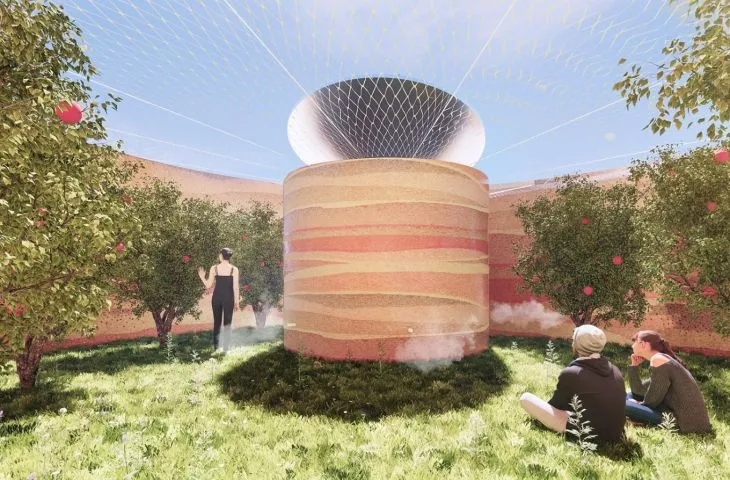We've heard a lot about organic gardens. Burning Man, a popular annual event that takes place in the desert in northern Nevada, has reported a demand for environmentally friendly installations.... The festival is known for its experimental designs. The idea of the Polish designers, however, is no ordinary ecological garden. What is "The Source", a spiral orchard by Tamaga studio?
This unusual project is a response to a competition that was organized in cooperation with the Land Art Generator Foundation. The foundation has been a long-time supporter of the Burning Man festival and primarily promotes ecological, sustainable development through new technologies and art. Where would the competition project be implemented? It's a site owned by the festival's organizers, located on a semi-desert rancho in Nevada, surrounded by a steppe landscape. The purpose of this space is to match the originality of all other spaces of this iconic festival. The architecture and landscaping is to have the function of a place to experience new, ecological solutions, opportunities to develop them and experiment.
The premise of the competition was to create an infrastructure facility at the intersection of architecture, design and landscape art to address the theme of sustainability and ecology in the context of 5 elements - energy, food, water, waste and shelter.
Tamaga studio | visualization
Among the group of finalists, was Poland's Tamaga studio, headed by Mateusz Gora and Agata Gryszkiewicz. Their unusual project "The Source" has a chance to be realized and be among the permanent buildings of the festival. It has already beaten more than 200 other works from around the world. Teams of architects, artists, activists, engineers entered the competition....
"The Source"
The project of Polish architects is an original garden inscribed in a sand spiral. A fruit orchard, surrounded by a winding wall compacted from local soil, colored with natural dyes that also color the local geyser. The spiral refers to the ancient language of petroglyphs found in the area, which in many cultures symbolizes life and rebirth. The wall itself uses a technology known since the 16th century called fruit walls: high thermal mass walls were the energy-efficient precursor of today's greenhouses. They create the right microclimate, protect from wind and will ensure the growth of trees and shrubs in difficult climates.
Tamaga studio | visualization
In the center of the spiral is the most important point, the water reservoir. A well that also collects rainwater from a gutter hollowed out at the top of the wall and from a special net stretched over the garden. On top of the structure is a photovoltaic panel that powers the lighting and mist irrigation system and stores unused energy in batteries.
Holes hollowed out in the wall encourage people to look in and visit the garden, but also act as a hotel for insects. Wild insects and bees, which will be an essential part of this small ecosystem, will have a safe haven.
Tamaga studio | visualization
The spiral orchard is intended not only as an ecological, experimental installation, but is ideal for meetings and educational workshops.
An important aspect of the sustainable design, it was also important for the project to foresee what would happen to the materials, after eventual demolition. The remains of the demolished wall, made of sand, can remain on the plot without harming the surrounding environment. Meanwhile, the remaining elements are recyclable.
Tamaga studio | visualization
let's experiment
The winning designs will be built as prototypes in the summer of 2021. A competition jury appointed by Burning Man organizers, the foundation and local architects will select the best implementations, which will later be transformed into permanent infrastructure for the iconic festival. And like Tamaga studio's design, the other ideas submitted to the competition not only demonstrate modern thinking about environmentally friendly architecture, but also prove that architecture is still open to experimentation, and that out-of-the-box forms have a chance to fit into the landscape. Could a similar spiral orchard be created in a Polish park as well?








































